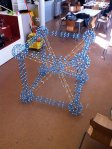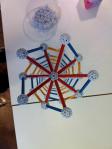A note for Sam Shah: This post is inspired by a conversation we had today. I’m going to wax education-philosophical for a while, and I apologize to you ahead of time because I know you don’t like to read that kind of stuff. But I promise – PROMISE – that I’m going to give some practical lesson advice at the end of the post. So please don’t drop off reading in the middle, ok?
__________________________________________________________________
If you read the note for Sam, you’ll know that this post is inspired by a conversation I had with my dear friend and education-world colleague Sam Shah today. Sam – being a totally awesome person – dropped by our first annual Mathematical Art Festival today to see what all the hoopla was about.
Want more pics? Check out our facebook page!
Yep – we had an all-day Mathematical Art (or MArTH) Festival today at Saint Ann’s. And it was a BLAST! We called it MArTH Madness. (Paul Salomon’s brilliant idea.) This didn’t just happen out of the blue – Paul Salomon, Justin Lanier, Max Neesemann, and I are leading a Mathematical Art seminar for high school students this semester, so MArTH has been happening around the school for a little while now.
This was the first time we did it with the whole school, and it was great fun! We had a bunch of different stations, led by teachers and students in our seminar – Escher tessellations, math doodling, 3D constructions, unit origami, 3D printing, computer-aided design… Kids and teachers made so much beautiful and fascinating art, and everyone had tons of fun.
As Sam and I were observing the creative chaos of the 3D constructions station (in the cafeteria, with ZOME tools), I asked him what he thought of it all. I won’t pretend to quote him directly, because I don’t remember exactly what he said – and, Sam, I apologize if I don’t get it quite right. But he said something along the lines of: I wish we could do this at my school, but we can’t – because your students already really like math, and mine don’t.
In the moment, I disagreed with him that he couldn’t do this at his school. But I agreed with him that our kids already like math. This wasn’t quite true.
I think I can say that a good number of my students like my classes. And I think I can say that a good number of students at Saint Ann’s in general like their math classes. But do most of our students like math? I don’t know about that.
But I don’t think their love of math was what was driving our students to tackle MArTH with so much enthusiasm today. I think it was simply that we gave them things to do that they were into.
Here’s something I think is true: People, and kids specifically, really like to make things. They also really like to test boundaries. MArTH is a perfect combination of these two things. You get to make really cool-looking things, and the way you make them is by following and pushing at the boundaries of mathematics. So, regardless of how much they like math, I think most kids would be really excited by mathematical art.
When students ask for “practical applications” of mathematics, I don’t think they’re necessarily asking for more problems having to do with “practical” things, like interest rates, grocery shopping, or draining water. I think they want something to do with the math they’re learning – a way to make something with it. MArTH is precisely that.
__________________________________________________________________
This looks like great fun, but how do I bring MArTH into my class, you may ask? Say I’m an Algebra 2 teacher. I’m totally not going to take a class period to make sonobe cubes or Appolonian gaskets. That would not be relevant to my curriculum. Alrighty. I can see why you wouldn’t want to do that.
But you’ll be teaching transformations of functions at some point, right? Maybe you’re doing it right now. Here’s a MArTH activity for you – in which your students will see function transformations in action AND made a beautiful work of mathematical art of their very own.
- Get your students computers with some good graphing software. Graphing calculators just won’t do it – the graphics are abominable. And you might want to be able to print at some point.
- Have them pick a basic function, or pick one for them. Something like f(x)=x^2 will do nicely.
- Tell them to choose a single type of transformation to make to the function. Shifts, stretches, flips. Then…
- Tell them to make small transformations of that type to the function. Graph each new function on the same screen.
- Huzzah! Art!
- Here’s the clincher, where the art really becomes their own: You now have to let them take it where they will. They may make the craziest of transformations. But, so long as they make small changes of their transformation type and graph them, they are making discoveries about the visual effects of algebraic transformations of functions. And they are making their own art.
I did this not too long ago with my algebra students, and wrote about it here.
If you do this, please let me know how it goes! If you want more MArTH activities, you know who to ask! And if you have any great MArTH activities of your own, you know who to share them with!







2 thoughts on “MArTH Madness!”